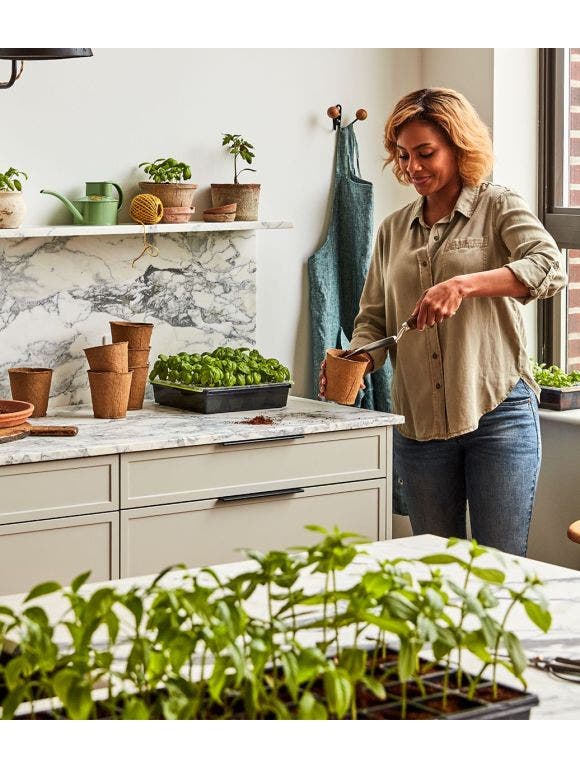
Why Start Seeds Indoors?
Much More Variety
You can buy seeds for many more vegetable varieties than you can find for sale as young plants. Starting from seeds indoors allows you to grow a wider range of flavors, shapes and colors of your favorite vegetables!
It’s Necessary for Some Plants
Many of our favorite vegetables—including tomatoes and peppers—are native to warmer climates where they get more time to grow outdoors than is possible in most of the United States. Their seeds will not sprout in cool spring soil, and fruits need more sun to ripen than is available in the waning days of autumn. If you were to sow tomato seeds outdoors in May in New England or the Midwest, plants would take so long to grow that the first frost in October would likely kill them before you got a single ripe tomato.
Earlier and Greater Yield
Even for crops that don't come from warmer climates, starting seeds indoors gives some plants a head start for earlier harvests and greater yield. The same is true for many of our favorite annual flowers. If you start them indoors, they can spend more time in your garden flowering and looking their most beautiful. Many perennials also benefit from indoor sowing!
Note that not all plants should be started indoors, and some are best sown directly in the garden (see this article on direct-sowing seeds). If you’re unsure of what to do, just refer to the directions on your seed packet.
Top 9 Seed Starting Tips
1. Don’t Take on Too Much
While you learn how seed starting works, indoor sow no more than a couple dozen plants in three or four varieties. It’s not complicated or difficult once you understand the process, but it’s best to start small so you don’t get overwhelmed at first.
2. Find a Good Growing Medium
Seedlings are very delicate. Start them in a fresh, sterile seed-starting mix that is light and fluffy and designed to hold just enough moisture. If the growing medium is too wet or not sterile, disease can strike. If it’s too heavy or sticky, fine new roots won't be able to push through it. Burpee has a range of great seed-starting mixes, from compressed coir pellets (made of coconut husk fibers) that expand when wet, to bags of loose seed-starting formula.
3. Choose the Right Container
Anything that will hold the growing medium and has drainage holes will work for indoor sowing, but we recommend specially designed seed starting kits because they include everything you need to grow strong, healthy seedlings. An alternative is biodegradable pots that break down in the soil.
4. Give Seedlings Plenty of Light
Seedlings need lots of light or they will be spindly and feeble. A sunny, south-facing window will do the trick for a handful of plants if you are not too far north, but artificial grow lights will ensure that your plants get the light they need even during shorter winter days. Leave the lights on for 16 hours and off for 8 hours at night, keeping the lights just 3-4 inches above the plants.
5. Provide Gentle Warmth
Seed starting happens in two stages: germination and growing. Germination is the sprouting stage, when the root and leaves emerge from the seed. You won't need light at this stage because it occurs under the soil, but you will need gentle warmth (not harsh heat). You can provide heat by using special heat mats. These will keep your seedlings about 10 degrees F warmer than the air temperature, allowing for faster germination. Once you see green sprouts about ½-inch tall, you need plant lights. You can remove heat mats as long as the room temperature is between 60-70 degrees F.
6. Keep Soil Evenly Moist
While water is essential for plant growth, overwatering is the most common cause of seedling failure. Sow seeds in an evenly pre-moistened mix. It should be moist but not soaking wet. Loosely cover the container to hold in humidity while seeds germinate, allowing for some air circulation. Burpee’s seed-starting kit lids are designed perfectly for this! Remove the lid after 50% of seeds have sprouted. Once plants are up, they need more light and air circulation to thrive.
7. Check Seeds Daily
This is the secret to successful seed starting: you should check your seeds daily. See if seeds have sprouted so you can remove the cover when it's time; make sure they stay properly moist but not too wet; check your reservoir if you have a self-watering kit; and monitor seedlings so you can raise lights as they grow taller. If you are starting seeds on a windowsill, turn plants every day so they don't bend toward the light.
8. Watch the Weather
Although a few crops can go outside earlier (refer to the seed packet), most should stay indoors until after the last frost date for your area has passed and your soil has warmed. If your area is having a cold spring, hold off. Gardeners are always eager, but many a carefully nurtured tomato seedling has been killed by a May frost or simply slowed down by cold soil.
9. ‘Harden Off’ Seedlings Before Transplant
Finally, introduce your plants to the sun gradually, a process called "hardening off". Expose them to sunlight for one hour more each day for a week. During this time bring them to a protected location outside when they are not in the sunlight. If there will be a frost at night, bring them inside. After a week or so, they will have acclimated to the outdoors and will be ready to transplant into your garden!
Are your seeds not sprouting? Learn the most common culprits for seeds not germinating, and how to fix them.






















